Detailed Analysis of How Businesses Operate: A Comprehensive Report
VerifiedAdded on 2023/01/11
|7
|1757
|25
Report
AI Summary
This report provides a comprehensive overview of business operations, covering key areas such as accounting, human resources, and employment legislation. It delves into the importance of accounting for business performance, detailing how it aids in financial decision-making and compliance. The report also explores the crucial functions of the HR department, including recruitment, employee relations, and training, as well as the key features of employment legislation. Furthermore, it includes an interpretation of a profit and loss account, an analysis of teamwork roles and responsibilities, and an examination of various motivation theories like Maslow's, Herzberg's, and McGregor's. Finally, it discusses different types of leadership styles, offering insights into democratic, autocratic, and transformational approaches to leadership, with the aim of educating students on essential aspects of starting and managing a business.
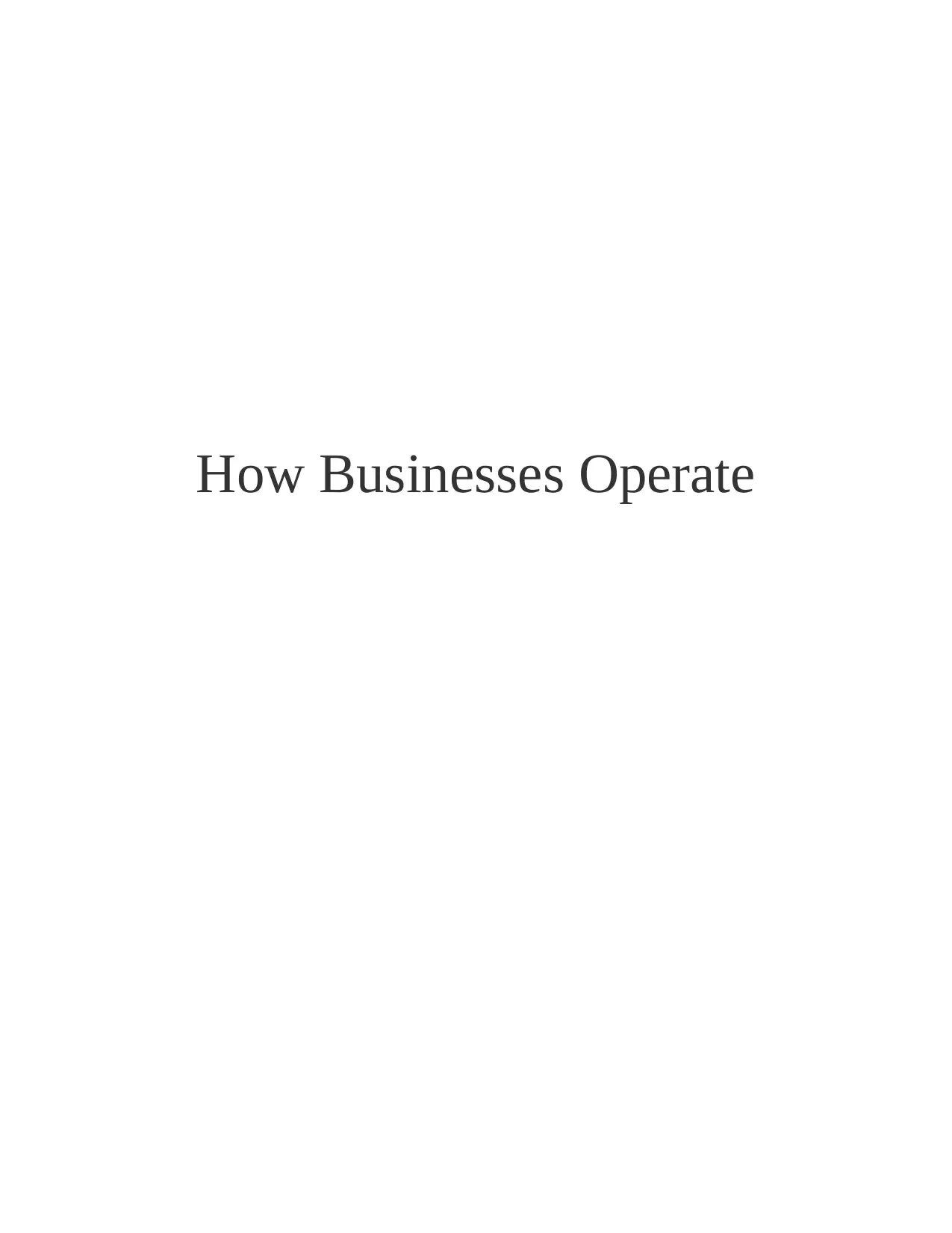
How Businesses Operate
Paraphrase This Document
Need a fresh take? Get an instant paraphrase of this document with our AI Paraphraser
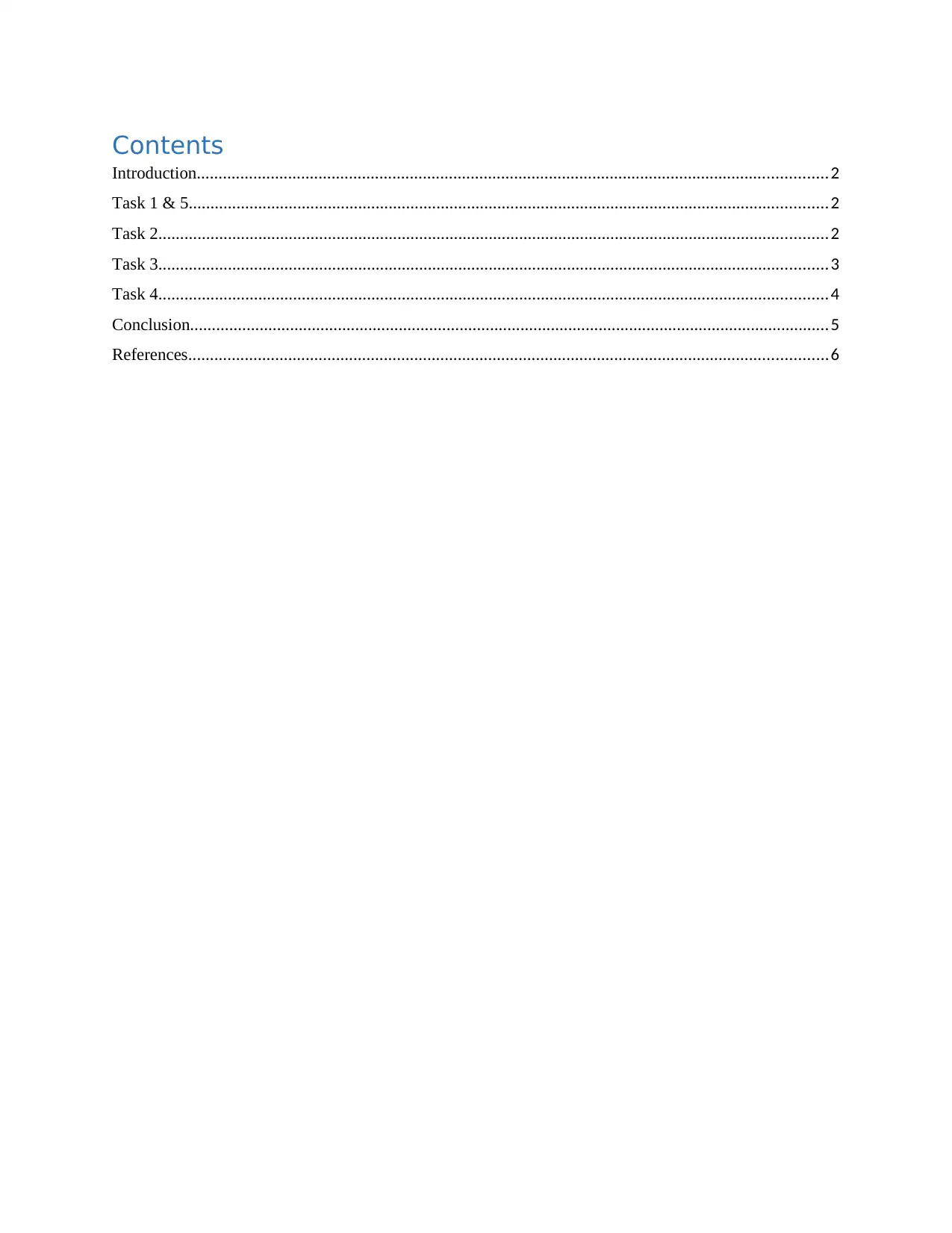
Contents
Introduction.................................................................................................................................................2
Task 1 & 5...................................................................................................................................................2
Task 2..........................................................................................................................................................2
Task 3..........................................................................................................................................................3
Task 4..........................................................................................................................................................4
Conclusion...................................................................................................................................................5
References...................................................................................................................................................6
Introduction.................................................................................................................................................2
Task 1 & 5...................................................................................................................................................2
Task 2..........................................................................................................................................................2
Task 3..........................................................................................................................................................3
Task 4..........................................................................................................................................................4
Conclusion...................................................................................................................................................5
References...................................................................................................................................................6
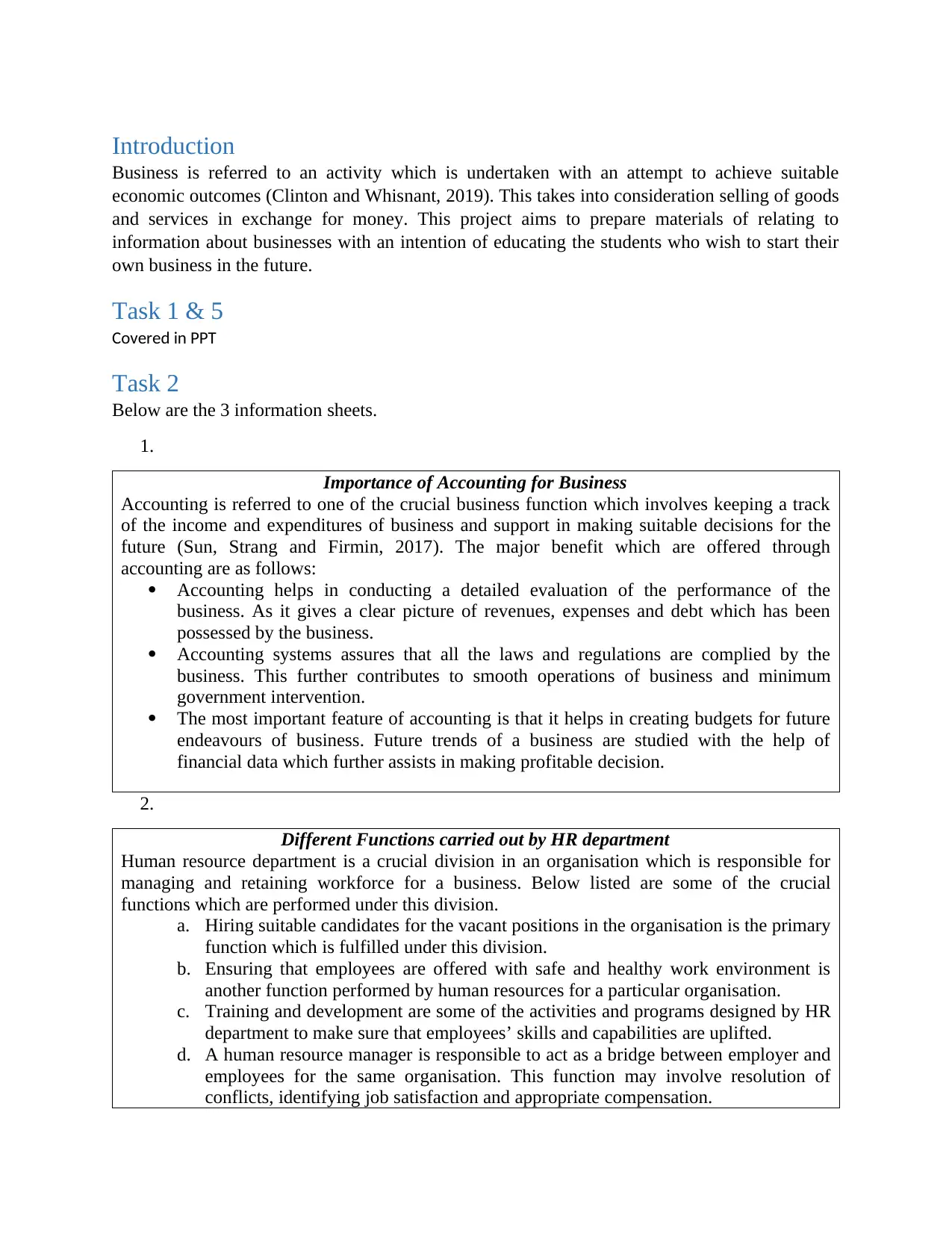
Introduction
Business is referred to an activity which is undertaken with an attempt to achieve suitable
economic outcomes (Clinton and Whisnant, 2019). This takes into consideration selling of goods
and services in exchange for money. This project aims to prepare materials of relating to
information about businesses with an intention of educating the students who wish to start their
own business in the future.
Task 1 & 5
Covered in PPT
Task 2
Below are the 3 information sheets.
1.
Importance of Accounting for Business
Accounting is referred to one of the crucial business function which involves keeping a track
of the income and expenditures of business and support in making suitable decisions for the
future (Sun, Strang and Firmin, 2017). The major benefit which are offered through
accounting are as follows:
Accounting helps in conducting a detailed evaluation of the performance of the
business. As it gives a clear picture of revenues, expenses and debt which has been
possessed by the business.
Accounting systems assures that all the laws and regulations are complied by the
business. This further contributes to smooth operations of business and minimum
government intervention.
The most important feature of accounting is that it helps in creating budgets for future
endeavours of business. Future trends of a business are studied with the help of
financial data which further assists in making profitable decision.
2.
Different Functions carried out by HR department
Human resource department is a crucial division in an organisation which is responsible for
managing and retaining workforce for a business. Below listed are some of the crucial
functions which are performed under this division.
a. Hiring suitable candidates for the vacant positions in the organisation is the primary
function which is fulfilled under this division.
b. Ensuring that employees are offered with safe and healthy work environment is
another function performed by human resources for a particular organisation.
c. Training and development are some of the activities and programs designed by HR
department to make sure that employees’ skills and capabilities are uplifted.
d. A human resource manager is responsible to act as a bridge between employer and
employees for the same organisation. This function may involve resolution of
conflicts, identifying job satisfaction and appropriate compensation.
Business is referred to an activity which is undertaken with an attempt to achieve suitable
economic outcomes (Clinton and Whisnant, 2019). This takes into consideration selling of goods
and services in exchange for money. This project aims to prepare materials of relating to
information about businesses with an intention of educating the students who wish to start their
own business in the future.
Task 1 & 5
Covered in PPT
Task 2
Below are the 3 information sheets.
1.
Importance of Accounting for Business
Accounting is referred to one of the crucial business function which involves keeping a track
of the income and expenditures of business and support in making suitable decisions for the
future (Sun, Strang and Firmin, 2017). The major benefit which are offered through
accounting are as follows:
Accounting helps in conducting a detailed evaluation of the performance of the
business. As it gives a clear picture of revenues, expenses and debt which has been
possessed by the business.
Accounting systems assures that all the laws and regulations are complied by the
business. This further contributes to smooth operations of business and minimum
government intervention.
The most important feature of accounting is that it helps in creating budgets for future
endeavours of business. Future trends of a business are studied with the help of
financial data which further assists in making profitable decision.
2.
Different Functions carried out by HR department
Human resource department is a crucial division in an organisation which is responsible for
managing and retaining workforce for a business. Below listed are some of the crucial
functions which are performed under this division.
a. Hiring suitable candidates for the vacant positions in the organisation is the primary
function which is fulfilled under this division.
b. Ensuring that employees are offered with safe and healthy work environment is
another function performed by human resources for a particular organisation.
c. Training and development are some of the activities and programs designed by HR
department to make sure that employees’ skills and capabilities are uplifted.
d. A human resource manager is responsible to act as a bridge between employer and
employees for the same organisation. This function may involve resolution of
conflicts, identifying job satisfaction and appropriate compensation.
⊘ This is a preview!⊘
Do you want full access?
Subscribe today to unlock all pages.

Trusted by 1+ million students worldwide
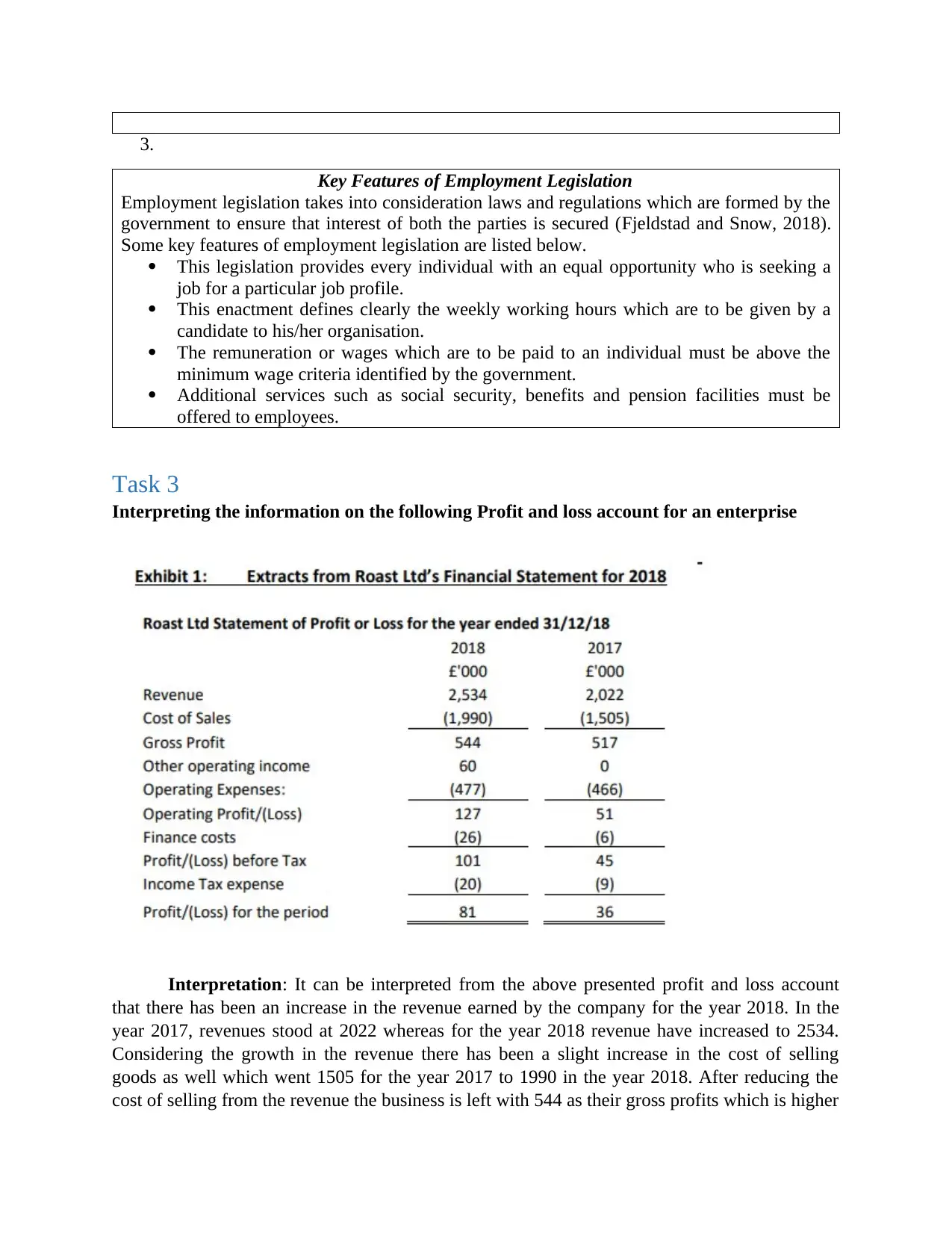
3.
Key Features of Employment Legislation
Employment legislation takes into consideration laws and regulations which are formed by the
government to ensure that interest of both the parties is secured (Fjeldstad and Snow, 2018).
Some key features of employment legislation are listed below.
This legislation provides every individual with an equal opportunity who is seeking a
job for a particular job profile.
This enactment defines clearly the weekly working hours which are to be given by a
candidate to his/her organisation.
The remuneration or wages which are to be paid to an individual must be above the
minimum wage criteria identified by the government.
Additional services such as social security, benefits and pension facilities must be
offered to employees.
Task 3
Interpreting the information on the following Profit and loss account for an enterprise
Interpretation: It can be interpreted from the above presented profit and loss account
that there has been an increase in the revenue earned by the company for the year 2018. In the
year 2017, revenues stood at 2022 whereas for the year 2018 revenue have increased to 2534.
Considering the growth in the revenue there has been a slight increase in the cost of selling
goods as well which went 1505 for the year 2017 to 1990 in the year 2018. After reducing the
cost of selling from the revenue the business is left with 544 as their gross profits which is higher
Key Features of Employment Legislation
Employment legislation takes into consideration laws and regulations which are formed by the
government to ensure that interest of both the parties is secured (Fjeldstad and Snow, 2018).
Some key features of employment legislation are listed below.
This legislation provides every individual with an equal opportunity who is seeking a
job for a particular job profile.
This enactment defines clearly the weekly working hours which are to be given by a
candidate to his/her organisation.
The remuneration or wages which are to be paid to an individual must be above the
minimum wage criteria identified by the government.
Additional services such as social security, benefits and pension facilities must be
offered to employees.
Task 3
Interpreting the information on the following Profit and loss account for an enterprise
Interpretation: It can be interpreted from the above presented profit and loss account
that there has been an increase in the revenue earned by the company for the year 2018. In the
year 2017, revenues stood at 2022 whereas for the year 2018 revenue have increased to 2534.
Considering the growth in the revenue there has been a slight increase in the cost of selling
goods as well which went 1505 for the year 2017 to 1990 in the year 2018. After reducing the
cost of selling from the revenue the business is left with 544 as their gross profits which is higher
Paraphrase This Document
Need a fresh take? Get an instant paraphrase of this document with our AI Paraphraser
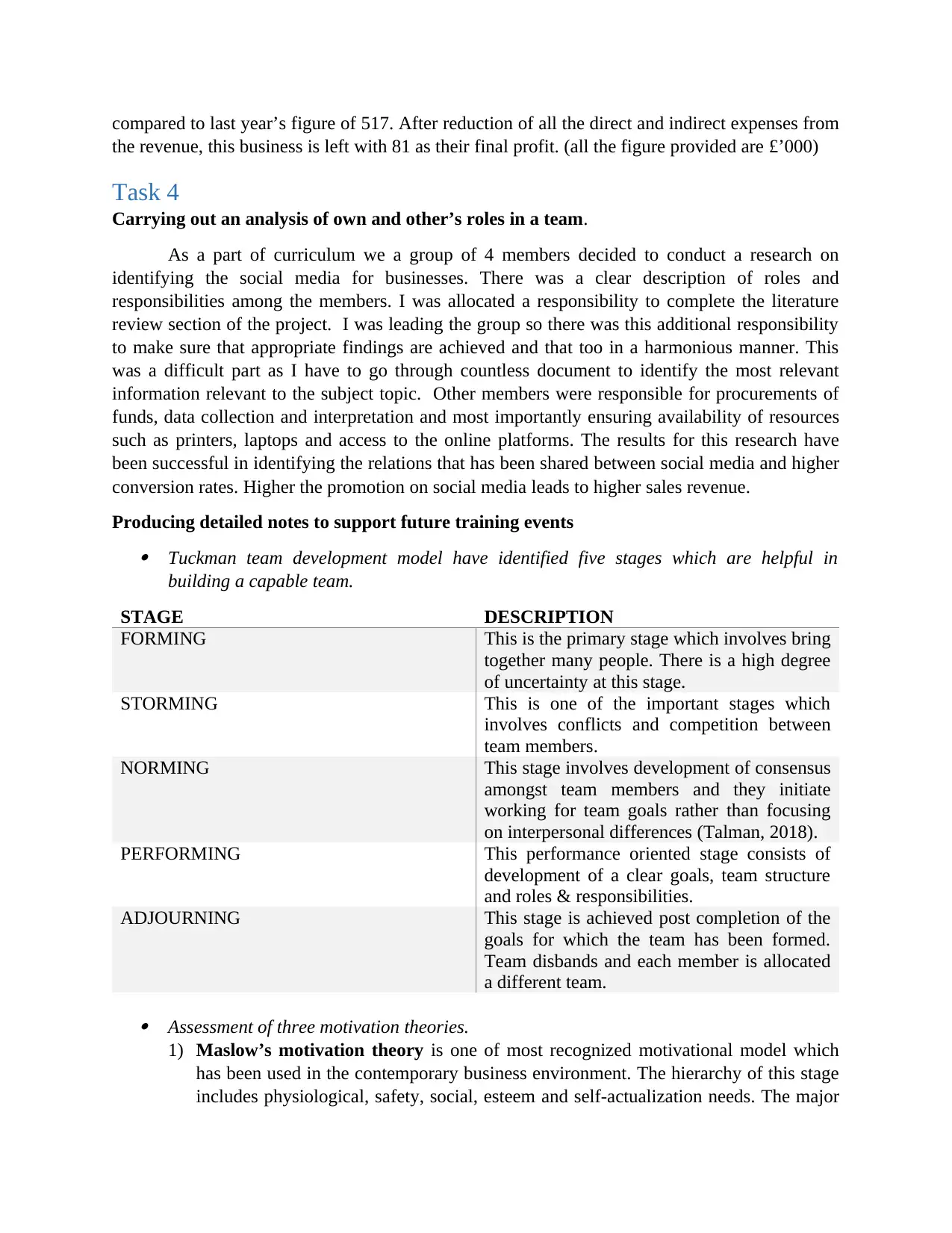
compared to last year’s figure of 517. After reduction of all the direct and indirect expenses from
the revenue, this business is left with 81 as their final profit. (all the figure provided are £’000)
Task 4
Carrying out an analysis of own and other’s roles in a team.
As a part of curriculum we a group of 4 members decided to conduct a research on
identifying the social media for businesses. There was a clear description of roles and
responsibilities among the members. I was allocated a responsibility to complete the literature
review section of the project. I was leading the group so there was this additional responsibility
to make sure that appropriate findings are achieved and that too in a harmonious manner. This
was a difficult part as I have to go through countless document to identify the most relevant
information relevant to the subject topic. Other members were responsible for procurements of
funds, data collection and interpretation and most importantly ensuring availability of resources
such as printers, laptops and access to the online platforms. The results for this research have
been successful in identifying the relations that has been shared between social media and higher
conversion rates. Higher the promotion on social media leads to higher sales revenue.
Producing detailed notes to support future training events Tuckman team development model have identified five stages which are helpful in
building a capable team.
STAGE DESCRIPTION
FORMING This is the primary stage which involves bring
together many people. There is a high degree
of uncertainty at this stage.
STORMING This is one of the important stages which
involves conflicts and competition between
team members.
NORMING This stage involves development of consensus
amongst team members and they initiate
working for team goals rather than focusing
on interpersonal differences (Talman, 2018).
PERFORMING This performance oriented stage consists of
development of a clear goals, team structure
and roles & responsibilities.
ADJOURNING This stage is achieved post completion of the
goals for which the team has been formed.
Team disbands and each member is allocated
a different team. Assessment of three motivation theories.
1) Maslow’s motivation theory is one of most recognized motivational model which
has been used in the contemporary business environment. The hierarchy of this stage
includes physiological, safety, social, esteem and self-actualization needs. The major
the revenue, this business is left with 81 as their final profit. (all the figure provided are £’000)
Task 4
Carrying out an analysis of own and other’s roles in a team.
As a part of curriculum we a group of 4 members decided to conduct a research on
identifying the social media for businesses. There was a clear description of roles and
responsibilities among the members. I was allocated a responsibility to complete the literature
review section of the project. I was leading the group so there was this additional responsibility
to make sure that appropriate findings are achieved and that too in a harmonious manner. This
was a difficult part as I have to go through countless document to identify the most relevant
information relevant to the subject topic. Other members were responsible for procurements of
funds, data collection and interpretation and most importantly ensuring availability of resources
such as printers, laptops and access to the online platforms. The results for this research have
been successful in identifying the relations that has been shared between social media and higher
conversion rates. Higher the promotion on social media leads to higher sales revenue.
Producing detailed notes to support future training events Tuckman team development model have identified five stages which are helpful in
building a capable team.
STAGE DESCRIPTION
FORMING This is the primary stage which involves bring
together many people. There is a high degree
of uncertainty at this stage.
STORMING This is one of the important stages which
involves conflicts and competition between
team members.
NORMING This stage involves development of consensus
amongst team members and they initiate
working for team goals rather than focusing
on interpersonal differences (Talman, 2018).
PERFORMING This performance oriented stage consists of
development of a clear goals, team structure
and roles & responsibilities.
ADJOURNING This stage is achieved post completion of the
goals for which the team has been formed.
Team disbands and each member is allocated
a different team. Assessment of three motivation theories.
1) Maslow’s motivation theory is one of most recognized motivational model which
has been used in the contemporary business environment. The hierarchy of this stage
includes physiological, safety, social, esteem and self-actualization needs. The major
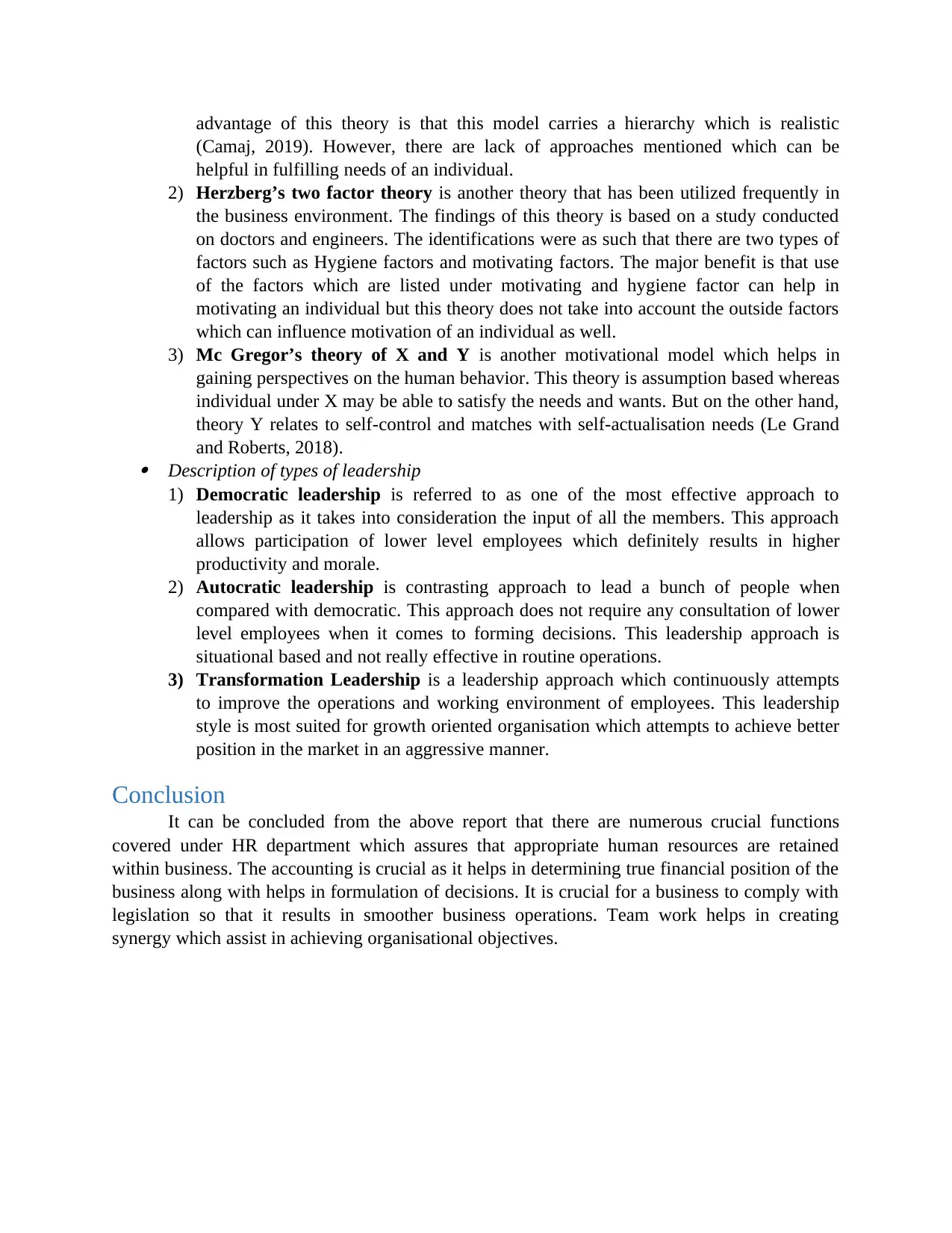
advantage of this theory is that this model carries a hierarchy which is realistic
(Camaj, 2019). However, there are lack of approaches mentioned which can be
helpful in fulfilling needs of an individual.
2) Herzberg’s two factor theory is another theory that has been utilized frequently in
the business environment. The findings of this theory is based on a study conducted
on doctors and engineers. The identifications were as such that there are two types of
factors such as Hygiene factors and motivating factors. The major benefit is that use
of the factors which are listed under motivating and hygiene factor can help in
motivating an individual but this theory does not take into account the outside factors
which can influence motivation of an individual as well.
3) Mc Gregor’s theory of X and Y is another motivational model which helps in
gaining perspectives on the human behavior. This theory is assumption based whereas
individual under X may be able to satisfy the needs and wants. But on the other hand,
theory Y relates to self-control and matches with self-actualisation needs (Le Grand
and Roberts, 2018).
Description of types of leadership
1) Democratic leadership is referred to as one of the most effective approach to
leadership as it takes into consideration the input of all the members. This approach
allows participation of lower level employees which definitely results in higher
productivity and morale.
2) Autocratic leadership is contrasting approach to lead a bunch of people when
compared with democratic. This approach does not require any consultation of lower
level employees when it comes to forming decisions. This leadership approach is
situational based and not really effective in routine operations.
3) Transformation Leadership is a leadership approach which continuously attempts
to improve the operations and working environment of employees. This leadership
style is most suited for growth oriented organisation which attempts to achieve better
position in the market in an aggressive manner.
Conclusion
It can be concluded from the above report that there are numerous crucial functions
covered under HR department which assures that appropriate human resources are retained
within business. The accounting is crucial as it helps in determining true financial position of the
business along with helps in formulation of decisions. It is crucial for a business to comply with
legislation so that it results in smoother business operations. Team work helps in creating
synergy which assist in achieving organisational objectives.
(Camaj, 2019). However, there are lack of approaches mentioned which can be
helpful in fulfilling needs of an individual.
2) Herzberg’s two factor theory is another theory that has been utilized frequently in
the business environment. The findings of this theory is based on a study conducted
on doctors and engineers. The identifications were as such that there are two types of
factors such as Hygiene factors and motivating factors. The major benefit is that use
of the factors which are listed under motivating and hygiene factor can help in
motivating an individual but this theory does not take into account the outside factors
which can influence motivation of an individual as well.
3) Mc Gregor’s theory of X and Y is another motivational model which helps in
gaining perspectives on the human behavior. This theory is assumption based whereas
individual under X may be able to satisfy the needs and wants. But on the other hand,
theory Y relates to self-control and matches with self-actualisation needs (Le Grand
and Roberts, 2018).
Description of types of leadership
1) Democratic leadership is referred to as one of the most effective approach to
leadership as it takes into consideration the input of all the members. This approach
allows participation of lower level employees which definitely results in higher
productivity and morale.
2) Autocratic leadership is contrasting approach to lead a bunch of people when
compared with democratic. This approach does not require any consultation of lower
level employees when it comes to forming decisions. This leadership approach is
situational based and not really effective in routine operations.
3) Transformation Leadership is a leadership approach which continuously attempts
to improve the operations and working environment of employees. This leadership
style is most suited for growth oriented organisation which attempts to achieve better
position in the market in an aggressive manner.
Conclusion
It can be concluded from the above report that there are numerous crucial functions
covered under HR department which assures that appropriate human resources are retained
within business. The accounting is crucial as it helps in determining true financial position of the
business along with helps in formulation of decisions. It is crucial for a business to comply with
legislation so that it results in smoother business operations. Team work helps in creating
synergy which assist in achieving organisational objectives.
⊘ This is a preview!⊘
Do you want full access?
Subscribe today to unlock all pages.

Trusted by 1+ million students worldwide
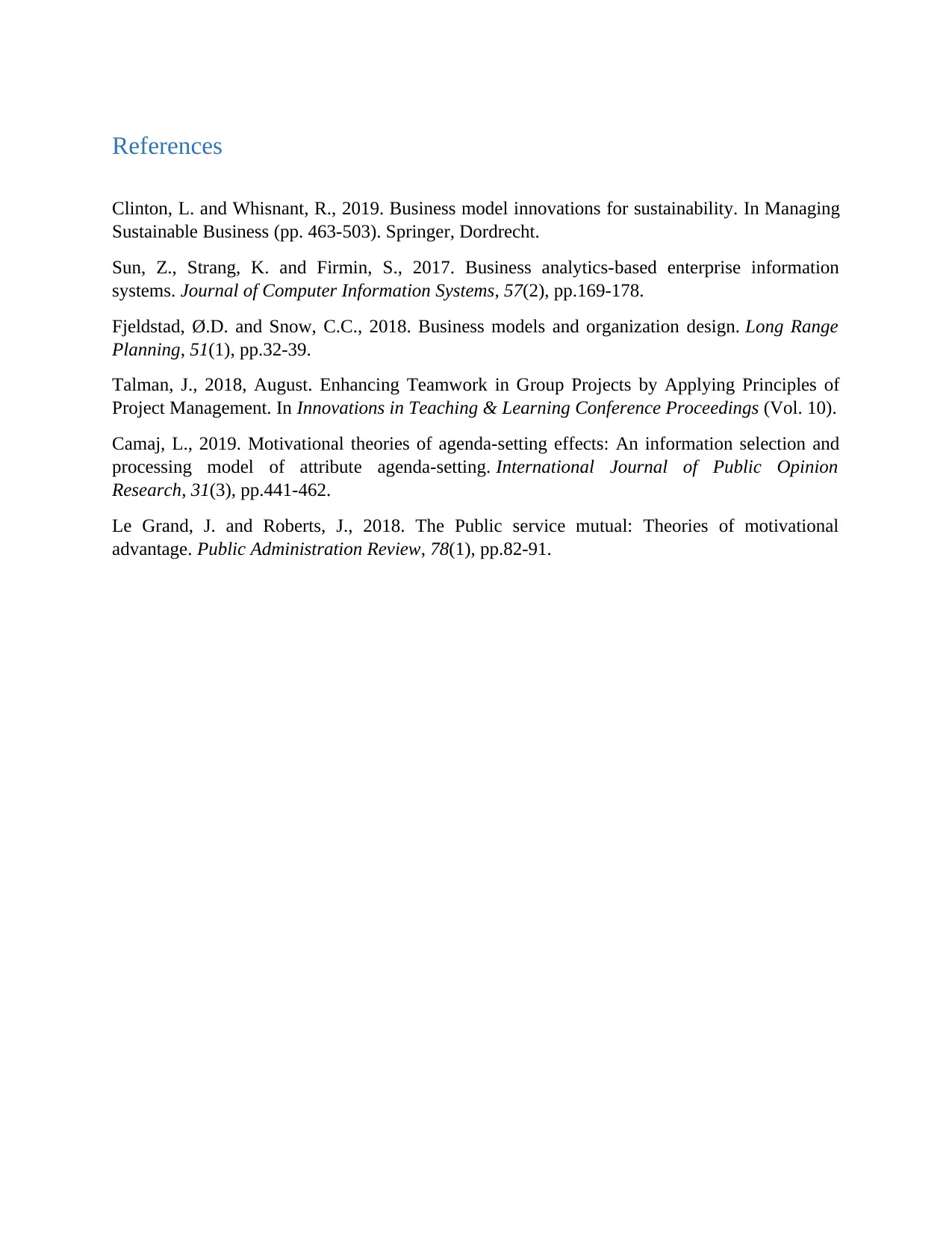
References
Clinton, L. and Whisnant, R., 2019. Business model innovations for sustainability. In Managing
Sustainable Business (pp. 463-503). Springer, Dordrecht.
Sun, Z., Strang, K. and Firmin, S., 2017. Business analytics-based enterprise information
systems. Journal of Computer Information Systems, 57(2), pp.169-178.
Fjeldstad, Ø.D. and Snow, C.C., 2018. Business models and organization design. Long Range
Planning, 51(1), pp.32-39.
Talman, J., 2018, August. Enhancing Teamwork in Group Projects by Applying Principles of
Project Management. In Innovations in Teaching & Learning Conference Proceedings (Vol. 10).
Camaj, L., 2019. Motivational theories of agenda-setting effects: An information selection and
processing model of attribute agenda-setting. International Journal of Public Opinion
Research, 31(3), pp.441-462.
Le Grand, J. and Roberts, J., 2018. The Public service mutual: Theories of motivational
advantage. Public Administration Review, 78(1), pp.82-91.
Clinton, L. and Whisnant, R., 2019. Business model innovations for sustainability. In Managing
Sustainable Business (pp. 463-503). Springer, Dordrecht.
Sun, Z., Strang, K. and Firmin, S., 2017. Business analytics-based enterprise information
systems. Journal of Computer Information Systems, 57(2), pp.169-178.
Fjeldstad, Ø.D. and Snow, C.C., 2018. Business models and organization design. Long Range
Planning, 51(1), pp.32-39.
Talman, J., 2018, August. Enhancing Teamwork in Group Projects by Applying Principles of
Project Management. In Innovations in Teaching & Learning Conference Proceedings (Vol. 10).
Camaj, L., 2019. Motivational theories of agenda-setting effects: An information selection and
processing model of attribute agenda-setting. International Journal of Public Opinion
Research, 31(3), pp.441-462.
Le Grand, J. and Roberts, J., 2018. The Public service mutual: Theories of motivational
advantage. Public Administration Review, 78(1), pp.82-91.
1 out of 7
Related Documents
Your All-in-One AI-Powered Toolkit for Academic Success.
+13062052269
info@desklib.com
Available 24*7 on WhatsApp / Email
![[object Object]](/_next/static/media/star-bottom.7253800d.svg)
Unlock your academic potential
Copyright © 2020–2025 A2Z Services. All Rights Reserved. Developed and managed by ZUCOL.





